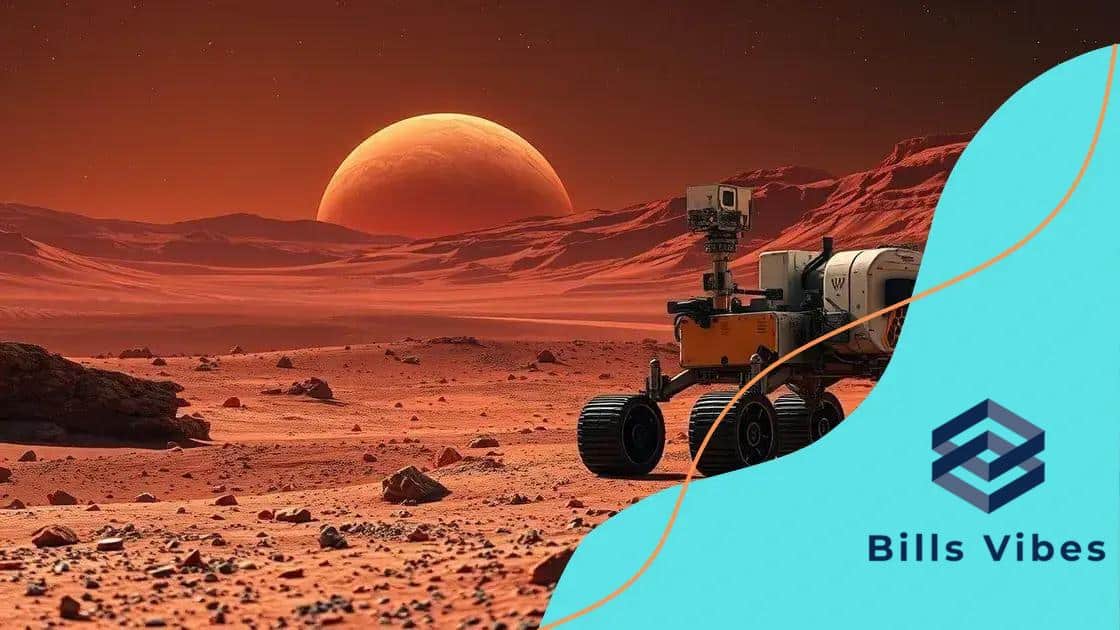Space missions to Mars: what challenges lie ahead?

Colonizing Mars involves overcoming significant challenges such as extreme temperatures, radiation exposure, and resource scarcity, while relying on technological advancements and international collaboration to create sustainable habitats for human life.
Space missions to Mars capture our imagination, don’t they? With each new launch, hopes soar high as we dream of what lies beyond. Let’s dive into the inspiring journeys ahead.
Key milestones in Mars missions
When we think about key milestones in Mars missions, several landmark events come to mind. Each mission has contributed significantly to our understanding of the Red Planet.
The First Flyby: Mariner 4
In 1965, the NASA spacecraft Mariner 4 made the first successful flyby of Mars. It provided the first close-up images of the Martian surface, sending back 21 photographs. This mission revealed a cratered landscape, which sparked curiosity.
Orbiters and Landers
Following Mariner 4, multiple missions followed:
- The Viking 1 and 2 missions in the 1970s were the first to land on Mars and conduct experiments.
- The Mars Global Surveyor, launched in 1996, mapped much of the planet’s surface.
- Spirit and Opportunity rovers landed in 2004, significantly advancing our knowledge about Martian geology.
The landers have sent back detailed data, helping scientists piece together Mars’ history. In 2012, the Curiosity rover landed in Gale Crater and has since been exploring Martian terrain and conducting tests for signs of life. Each success builds on the last, paving the way for future exploration.
The Latest Endeavors
More recent missions, like the Mars 2020 Perseverance rover, are key for future human exploration. Perseverance has been collecting samples and searching for signs of past life, aiming to gather crucial information for the next stages. The collaboration between various space agencies has made these advances possible, showcasing human ingenuity.
The achievements in Mars exploration illustrate our thirst for knowledge about space and our universe. The journey so far is not just about reaching Mars, but understanding the conditions that make the planet unique.
As we celebrate these milestones, we look forward to upcoming missions and the potential for human exploration. The future holds exciting opportunities and discoveries that could change our understanding of life beyond Earth.
Technological advancements for Martian exploration
Technological advancements for Martian exploration have rapidly transformed how we understand the Red Planet. Each innovation has played a crucial role in improving our missions and expanding our knowledge.
Rover Technology Evolution
The first rovers were simple, but now they are equipped with advanced technology. Modern rovers like Perseverance are designed with cutting-edge tools:
- High-resolution cameras for detailed imaging
- Scientific instruments for analyzing soil and rocks
- Autonomous navigation systems for safe travel
These innovations help scientists gather data more efficiently. The ability to conduct in-situ analysis means we can learn more during missions, rather than waiting for samples to return to Earth.
Communication Systems
Strong communication systems have also evolved. Previously, the data transfer rates were slow. Now, satellites in orbit facilitate faster communication between Earth and Mars:
- Advanced antennas improve signal strength and clarity
- Relay satellites reduce communication lag
- Data compression technologies allow for efficient transmission
This means we receive images and data more quickly, enhancing real-time decision-making.
Artificial intelligence has become crucial in processing the massive amounts of data collected. AI helps in identifying interesting features, allowing researchers to focus on areas that may hold signs of life. Robots equipped with machine learning algorithms can operate autonomously, performing tasks without constant human intervention. This capability is vital for missions far from Earth.
With innovations in 3D printing, future missions may rely on printing structures on Mars instead of transporting everything from Earth. This approach reduces costs and makes constructing habitats feasible. As technology advances, our possibilities for exploration expand. Partnering with private companies inspires next-generation technologies, leading to more ambitious missions.
The journey to Mars is a testament to human creativity and ingenuity. As we move forward, each step promises exciting discoveries that will deepen our understanding of our universe.
The role of international collaboration

The role of international collaboration in Mars exploration has been pivotal for the success of various missions. By combining resources, expertise, and technology, countries working together can tackle challenges and achieve remarkable goals.
Shared Resources and Knowledge
International partnerships allow space agencies to share their resources and knowledge. This can lead to:
- Cost savings through shared funding.
- Access to advanced technologies developed by different nations.
- Pooling scientific expertise to analyze Martian data more effectively.
For example, the European Space Agency (ESA) has worked with NASA on numerous missions, benefiting from a blend of scientific knowledge and technological innovation.
Joint Missions
Joint missions have gained popularity in recent years. Missions like the ExoMars project highlight how countries can collaborate on ambitious goals:
- ESA and Roscosmos are developing a rover as part of the ExoMars program.
- NASA collaborates with these agencies to enhance the overall scientific return for Martian exploration.
- These partnerships can minimize risks associated with single-country missions.
Bringing together diverse perspectives fosters creativity and improves the chances of mission success. Cooperation also helps prepare for future human exploration by addressing shared challenges in technology and safety.
As we look at the future of exploration, it is clear that international collaboration will play a critical role. Countries like India, Japan, and the UAE are also entering the field, broadening the collaboration spectrum. Their contributions enhance global knowledge about Mars and strengthen our quest for understanding life beyond Earth.
The shared vision of exploring Mars encourages nations to unite efforts, making the journey an inspiring global endeavor rather than just a solitary race to the Red Planet.
Challenges of living on Mars
The challenges of living on Mars are numerous and complex. As we dream of sending humans to the Red Planet, we must confront harsh conditions that differ significantly from Earth.
Extreme Temperatures
One major issue is the extreme temperatures on Mars. Daytime highs can reach up to 70 degrees Fahrenheit, while nighttime lows can drop to -195 degrees Fahrenheit. This wide temperature range poses serious challenges:
- Creating habitats that can withstand these conditions.
- Developing heating systems to keep humans warm during cold nights.
- Protecting equipment from thermal stress.
Addressing temperature extremes is crucial for the safety and comfort of Martian settlers.
Radiation Exposure
The thin atmosphere on Mars fails to offer significant protection from cosmic radiation. This is a serious concern for long-term human health. Potential solutions include:
- Building habitats underground or using Martian regolith as shielding.
- Designing protective suits for outside exploration.
- Implementing monitoring systems to track radiation levels.
Reducing exposure to harmful radiation is vital for the well-being of future astronauts.
Another significant challenge is the scarcity of water. While scientists have found signs of water ice, accessing and utilizing this resource will be essential. Innovative technologies will be needed to extract water from ice and recycle it for use within habitats. Gardening also poses a problem; growing food requires careful management of resources. Without reliable agriculture systems, a sustained human presence could be difficult.
In addition to physical challenges, psychological factors must also be considered. The isolation and distance from Earth can impact mental health. Developing strong support systems and recreational activities will help maintain crew morale during long missions.
All these factors contribute to the complexity of living on Mars. Solutions are needed to create a sustainable environment for human life on this distant planet.
Future prospects for Mars colonization
The future prospects for Mars colonization are filled with excitement and challenges. As we gather more information from missions, our dreams of establishing a human presence on the Red Planet become more feasible.
Building Sustainable Habitats
One of the most critical aspects is creating sustainable habitats. These habitats must protect humans from harsh weather, including extreme temperatures and radiation. Innovations such as:
- Use of Martian materials for construction
- 3D printing technologies for building structures
- Underground living to shield from radiation
are essential for ensuring the safety and comfort of future colonists.
Life Support Systems
Advanced life support systems are crucial for Mars colonization. This includes:
- Reliable ways to generate oxygen, possibly through electrolysis of water.
- Water recycling systems to minimize waste and maximize resources.
- Food production methods, like hydroponics, to sustain a healthy diet.
These systems must be efficient to support a growing population over time.
Research will inform how we manage resources on Mars effectively. For instance, developing technology for extracting water from the Martian soil or atmosphere is vital for survival. Scientists are already studying the potential for farming on Mars. Imagine greenhouses that use solar energy to grow food in the Martian landscape!
Moreover, collaboration between nations and private companies is essential. As more organizations invest in space travel, the possibilities expand. Innovations are likely to emerge from partnerships that might see technology adapted for the unique challenges of Mars.
Robotic technologies will also play a key role. Before any human sets foot on Mars, autonomous robots could pave the way, preparing habitats, and establishing infrastructure.
Additionally, with continuous advancements, there might be missions aimed at bringing back samples from Mars to Earth for better analysis. This research will provide insights necessary for future colonization efforts, helping scientists understand how to thrive on Mars.
FAQ – Frequently Asked Questions about Mars Colonization
What are the main challenges of living on Mars?
The main challenges include extreme temperatures, radiation exposure, and limited access to water and resources.
How can we create sustainable habitats on Mars?
Sustainable habitats can be built using Martian materials and advanced technologies like 3D printing.
What role does international collaboration play in Mars missions?
International collaboration allows countries to share resources, knowledge, and technology, making missions more effective.
How will robots assist future human settlers on Mars?
Robots will help prepare habitats, establish infrastructure, and conduct research before humans arrive on Mars.






